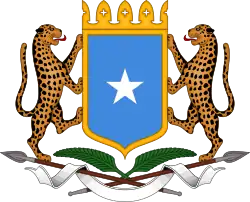Christianity in Somalia
Christianity is a minority religion in Muslim-majority Somalia, with an estimated 1,000 practitioners in a population of over 10 million inhabitants.[1][2] Most Christian adherents come from the Bantu ethnic minority group,[3] or are descended from Italian colonists and belong to the Evangelical and Wesleyan Church of the Nazarene. There is one Catholic diocese for the entire country, the Diocese of Mogadishu.
| Christianity by country |
|---|
 |
|
|
Overview
The Diocese of Mogadishu estimates that there were about 100 Roman Catholic practitioners in Somalia in 2004. This was down from a high of 8,500 adherents at the start of the trusteeship period in 1950, under the Prefecture Apostolic of Benadir of the Vicariate Apostolic of Mogadiscio.[4]
Thirty-seven years earlier, in 1913, during the early part of the colonial era, there were virtually no Christians in the Somali territories. Around 100–200 followers existed in the schools and orphanages of the few Catholic missions in the British Somaliland protectorate.[5] No Catholic missions are known to have existed in Italian Somaliland during the same period.[6]
However, after World War I Catholicism started to be promoted in "Somalia italiana", as Listowel wrote:
In 1903 the Trinitarian Fathers were the first missionaries to arrive in what was to become Somalia. They started teaching and providing social assistance to the poor and the sick. Fr. Jelib set up a leper colony at the mouth of the Juba river, and cared for about 350 to 400 lepers. In 1924 the Consolata Fathers and Sisters (from Turin) arrived; the Fathers to be replaced in the 1930s by the Franciscan Friars Minor from the Milan Province.
In 1928, a Catholic cathedral was built in Mogadishu by order of Cesare Maria De Vecchi, a Catholic governor of "Somalia italiana" who promoted the "Missionari della Consolata" Christianization of Somali people.[7] The cathedral, the biggest in Africa in the 1920s and 1930s, was later damaged during the civil war that began in the 1980s.
The Bishop of Mogadishu, Franco Filippini, declared in 1940 that there were about 40,000 Somali Catholics due to the work of missionaries in the rural regions of Juba and Shebelle, but World War II damaged in an irreversible way most of the Catholic missions in Italian Somalia.[8] Most were Somali Bantu,[9] but some thousands were illegitimate sons of Italian soldiers and Somalian girls (who received Italian citizenship when baptized).
The Bible was first translated into Somali only in 1979.[10]
According to the World Christian Encyclopedia, the Somalia Believers Fellowship, the Somalia Mennonite Mission and the Seventh-day Adventists are present in this country.[11] Somalia is included in the Episcopal Area of the Horn of Africa of the Anglican Diocese of Egypt, though there are no current local congregations.[12] The Adventist Mission indicates that there are no Adventist members in Somalia, and that Christianity in general has seen little growth there.[13]
Persecution by Muslims
Due to the ongoing civil war in the southern part of the country, professing Christians in Somalia have faced persecution and sometimes death. Apart from Mogadishu Cathedral (which is no longer used for Christian services, although in 2013 plans to repair it were announced by the Diocese of Mogadiscio), there are no church buildings in the country. Nor is there any legal protection for Christians, some of whom meet in underground churches.[1]
Paramilitary groups in Somalia have also engaged in widespread looting of Christian graves,[14] in addition to the desecration of Sufi Muslim graves and mosques.[15] Sometimes the term "Christian" was a label that the jihadists would affix on people they suspected of working for Ethiopian intelligence.[1]
In August 2009, International Christian Concern reported that four Christians working to help orphans in Somalia were beheaded by Islamist extremists when they refused to convert to Islam.[16]
In December 2013, the Ministry of Justice and Religious Affairs released a directive prohibiting the celebration of Christian festivities in the country.[17]
See also
Notes
- "Almost expunged: Somalia's Embattled Christians". October 22, 2009. Archived from the original on July 23, 2011. Retrieved October 22, 2009.
- Department of Economic and Social Affairs Population Division (2009). "World Population Prospects, Table A.1" (.PDF). 2008 revision. United Nations. Retrieved March 12, 2009. Cite journal requires
|journal=(help) - A study on minorities in Somalia
- "Catholic Church in Somalia". Diocese of Mogadishu. Retrieved 7 April 2015.
- Charles George Herbermann, The Catholic encyclopedia: an international work of reference on the constitution, doctrine, discipline, and history of the Catholic church, Volume 14, (Robert Appleton company: 1913), p.139.
- Charles Henry Robinson, History of Christian Missions, (Read BOoks: 2007), p. 356.
- The Catholic missionaries of "Consolata" promoted by governor De Vecchi (in Italian)
- Tripodi, Paolo. The Colonial Legacy in Somalia. p. 66
- Photo of Somali Bantu with a Missionary of the "Consolata" in 1937
- "Version Information". Bible Gateway. Retrieved 7 April 2015.
- World Christian Encyclopedia, (2nd edition), Volume 1, p. 673
- The Episcopal Area of the Horn of Africa
- "Global Mission's Top 10 Places to Pray for – Region: North Africa – Somalia". Adventist Mission. Archived from the original on 1 October 2011. Retrieved 7 April 2015.
- "Widspread [sic] desecration of Christian graves in Somalia". Catholic World News. Trinity Publications. January 19, 2005. Retrieved October 18, 2017.
- Sheikh, Abdi (October 19, 2009). "Shabaab rebels destroy grave and mosque in Somalia". Reuters. Retrieved October 18, 2017.
- "Al Shabaab Reportedly Beheads many Christians, Rips Gold Teeth From Locals' Mouths". FOX News. August 12, 2009. Retrieved June 11, 2011.
- Khalif, Abdulkadir (25 December 2013). "Somalia bans Christmas celebrations". Daily Nation. Archived from the original on 11 December 2017. Retrieved 3 January 2014.

